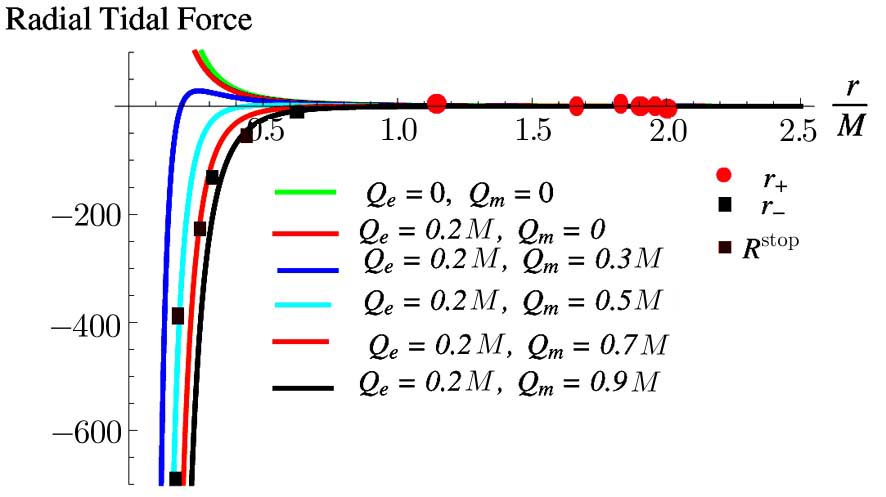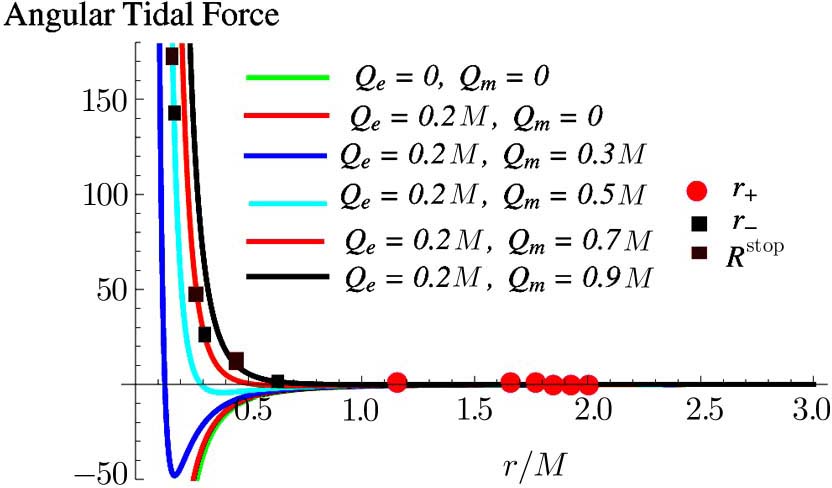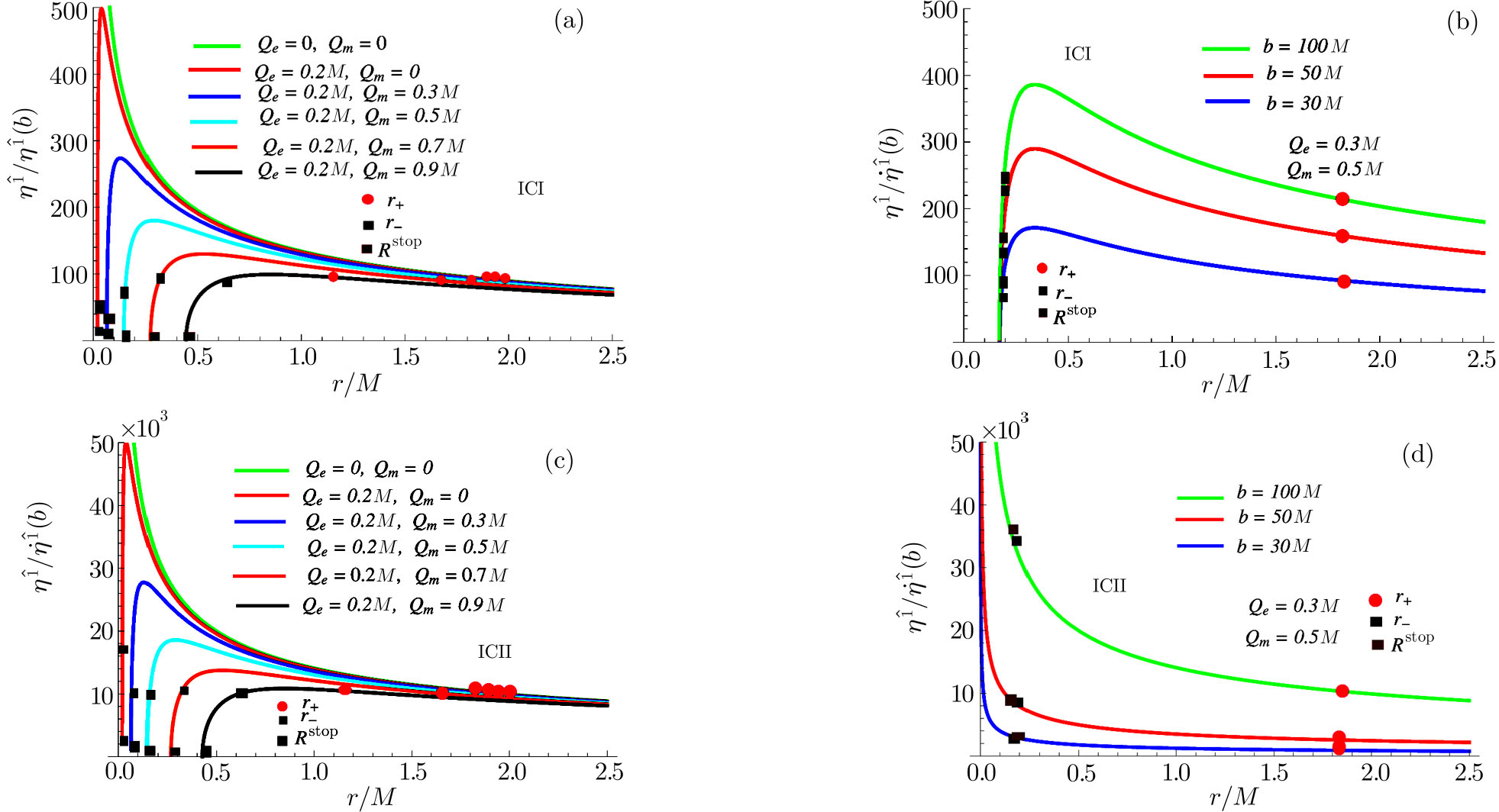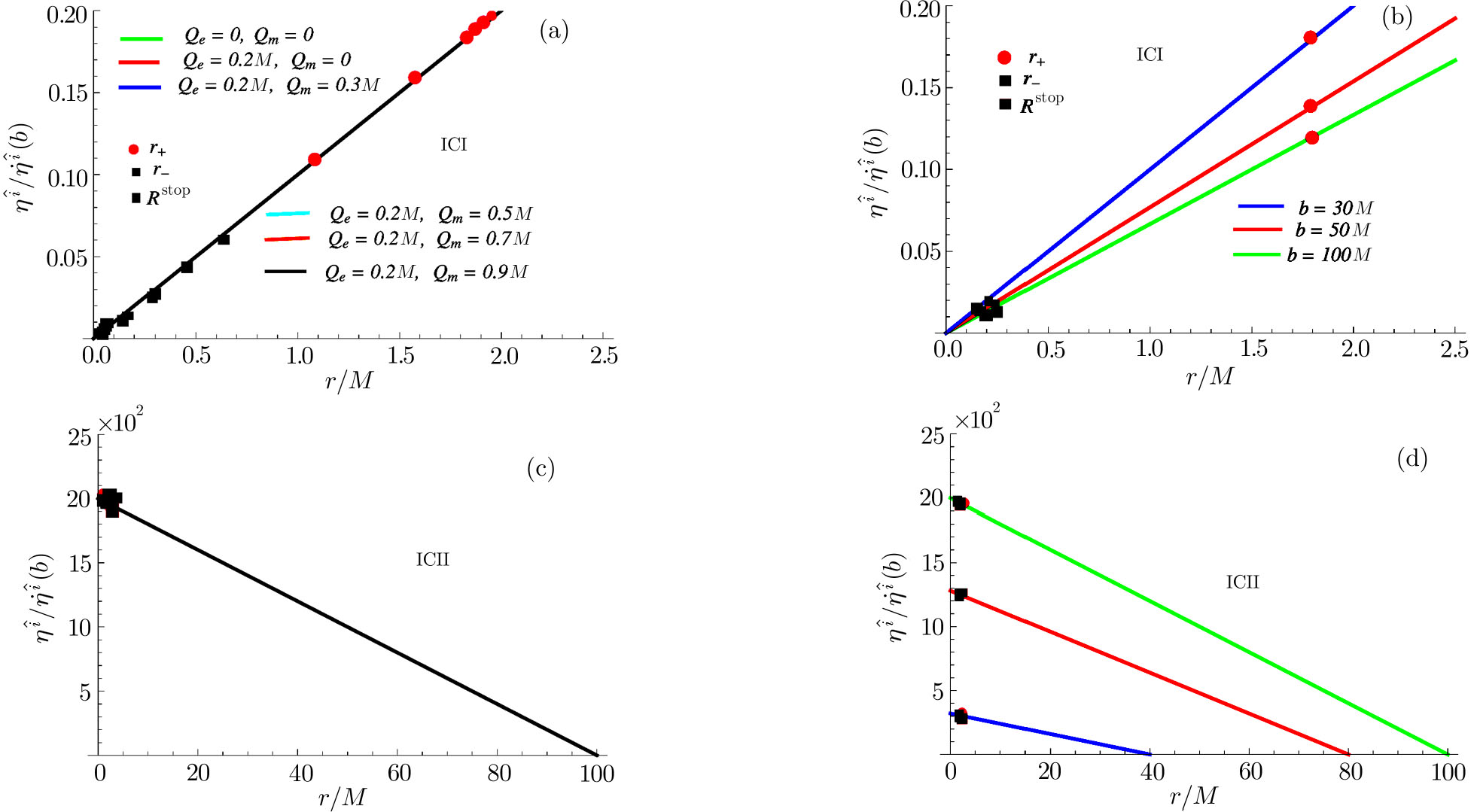† Corresponding author. E-mail:
This paper investigates the tidal as well as magnetic charge effects produced in dyonic Reissner-Nordström black hole. We evaluate Newtonian radial acceleration using radial geodesics for freely falling test particles. We establish system of equations governing radial and angular tidal forces using geodesic deviation equation and discuss their solutions for bodies falling freely towards this black hole. The radial tidal force turns out to be compressing outside the event horizon whereas the angular tidal force changes sign between event and Cauchy horizons unlike Schwarzschild black hole. The radial geodesic component starts decreasing in dyonic Reissner-Nordström black hole unlike Schwarzschild case. We conclude that magnetic charge strongly affects the radial as well as angular components of tidal force.
One of the crucial developments on the landscape of astrophysics is the detection of black holes (BHs) as well as mysteries behind its origin. Our modern perspective for conclusive evidences of BHs introduces a new vision of tidal effects around them. The study of BHs has been a subject of interest for scientific community and researchers since many years for a variety of reasons. The fascinating nature of BHs makes them curious exotic entities of the universe. It is widely accepted that BHs are formed as a result of gravitational collapse of a massive star.[1] Recent developments assure that BHs exhibit a strong gravitational pull such that nothing can escape from its gravitational field not even a light ray. Due to this alluring feature, the interior region of BH cannot be observed directly by an external observer as it is enveloped by an event horizon (a point of no return). Black holes being high curvature regions can never be destroyed by the external fields.
Any state of matter that enters into a BH encounters a change in its mass, charge and angular momentum. It is well-known that BHs pull everything towards them instead of throwing it out.[2] Its internal information can be studied by investigating the geodesics around them. Geodesics are crucial to investigate physical significance of a given spacetime as they provide considerable insights to analyze the internal structure of BHs. There exists a variety of BHs depending upon their characterizing parameters. Schwarzschild BH (uncharged) is the simplest one having only mass parameter while Reissner-Nordström (RN) (electrically charged) and Kerr (rotating) BHs contain some more parameters. Later on, regular, tidal charged, dyonic BHs etc. have been presented.
The no-hair theorem[3] of classical general relativity states that stationary BHs could be characterized by three parameters, i.e., mass, charge and angular momentum. The RN spacetime described by mass as well as electric charge possesses a horizon and therefore describes a BH if M2 ≥ Q2. If this inequality is not satisfied then the metric describes a naked singularity. Black holes also possess a magnetic charge if such existed. A particle with electric and magnetic charge is called a dyon and a BH having dyon is termed as dyonic BH. This BH is of special interest as it allows one to study spherical configurations with magnetic charge.[4] The interest in the possibility of dyonic BHs has grown since magnetic monopoles have been predicted in various extensions of the standard model of particle physics. The metric of dyonic RN BH is identical to RN BH with replacement 
It is well-known that magnetic monopoles present in grand unification theories give rise to dyonic BHs.[5] Stuchlik[6] investigated motion of charged particles near dyonic Kerr-Newmann de Sitter spacetime. Semiz[7] found the validity of cosmic censorship conjecture near dyonic BHs. Virbhadra and Parikh[8] discussed BH characterized by scalar, electric and magnetic charges having curvature singularity at r = 0 similar to RN BH. Ghosh and Mitra[9] studied entropy of dyonic BH in extremal case and found its dependance on mass or charge rather than its area. Sharif and Iftikhar[10] explored neutral as well as charged particle dynamics in the vicinity of dyonic RN BH and concluded that both electric and magnetic charges strongly influence the particles moving around this BH. These studies motivated researchers to consider dyonic BHs for their astrophysical ramification.
Many surveys have been done for the extensive description of tidal forces near BHs. Mashnoon and Theiss[11] studied relativistic tidal forces for a rotating system and provided a technique for their measurement. Kostić et al.[12] made a theoretical survey for the tidal effects near massive BHs and found tidal effects too intense to melt highly massive solid objects in the vicinity of BH. Brito et al.[13] investigated tidal effects in higher-dimensional BH and pointed out that more energy can be extracted from BH in case of higher dimensions. Fuchs[14] proposed a general formalism for the solution of geodesic deviation equations for static spherically symmetric spacetimes. Bażański and Jaranowski[15] discussed a solution of geodesic deviation equations for Schwarzschild BH.
This paper is devoted to investigate the effects of magnetic charge on tidal forces in the vicinity of dyonic RN BH. The format of the paper is as follows. In next section, we introduce the metric of dyonic RN BH and discuss Newtonian radial acceleration. Section
In this section, we study the effects of magnetic charge on tidal forces for dyonic RN BH. The line element for this BH is given by






Now we discuss radial geodesics of neutral test particles near dyonic RN BH. We consider 









In this section, we investigate tidal forces in the vicinity of dyonic RN BH. We consider a sphere consisting of two (non-interacting) particles falling towards the center of earth. Since particles near the earth will move faster due to its strong gravitational attraction, so the sphere does not retain its shape and becomes an ellipsoid. Likewise, a body falling towards any spherical region encounters distortion in it but for BHs this effect becomes infinite due to singularity. Therefore, a body near BH experiences infinite stretching and compression in it.
The geodesic deviation equation develops a relation between any two closed freely falling test particles and curvature by the following[18–19]

The Jacobi field is a vector field along a geodesic, which provides the difference between geodesic and an infinitesimally close geodesic. In order to explore the behavior of Jacobi fields, we define tetrad basis for freely falling test particles in the radial direction as
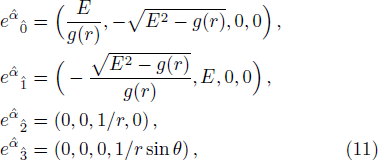





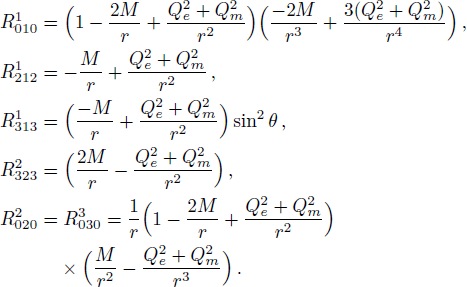



Here, we discuss tidal force in the radial direction. Using Eqs. (




Here we examine tidal force in the angular direction. Using Eqs. (


In this section, we evaluate geodesic deviation vectors to understand the stretching or compressing behavior of freely falling test particles around dyonic RN BH. The geodesic deviation equations provide relativistic acceleration between freely falling test particles in a gravitational field. The exact solution of these equations provide a better understanding of the nature of separation between geodesics.[22] For this purpose, we solve Eqs. (




Let us consider a geodesic for a body falling freely from r = b > r+. The geodesic deviation equations yield the following results









Figure 







For ICII, the radial component always increases for a body that falls freely from r = b to r+. For the charged case, during the radial infall of a body from r = r+ to r = r−, the geodesic components in the radial direction tend to increase, attain its maximum then decrease until it reaches r−. During the radial infall of a body between r− and Rstop, the corresponding radial components continue to decrease and ultimately reduce to zero at Rstop. The radial geodesic component with condition ICI behaves identical to ICII except for 
In this paper, we have explored the effects of magnetic charge on tidal forces in the context of dyonic RN BH. We have evaluated Newtonian radial acceleration using radial geodesics and radial as well as angular tidal force components using geodesic deviation equation. We have studied solutions of the geodesic deviation equations. The results are summarized as follows.
It is found that tidal force depend upon charge-to-mass ratio of dyonic RN BH. We have also found that the tidal effects near charged and uncharged BHs are quite different from the effects near the horizon of BH. It is well-known that the tidal forces cause the body to be radially stretched while compressed in the angular direction for the Schwarzschild BH. For charged BHs, the tidal forces can stretch or compress a body in any direction.[20] For dyonic RNBH, the strength of this tidal force depends upon charge-to-mass ratio that involves both electric and magnetic charges. It turns out that geodesic deviation vector behaves qualitatively identical for charged and uncharged BHs away from the horizon. However, the corresponding vector behaves quite differently for Schwarzschild, RNand dyonic RN BHs inside the event horizon. In particular, the radial geodesic component vanishes for certain initial conditions but its angular components remain finite for charged BHs. For uncharged BHs, the radial geodesic components become infinite, whereas the corresponding angular components become zero near the singularity.[23–24] Thus, a magnetic charge plays a substantial role in stretching and compression of bodies near dyonic RN BH. It is worth mentioning here that the results for RN BH can be recovered with Qm = 0.[20]
| [1] | |
| [2] | |
| [3] | |
| [4] | |
| [5] | |
| [6] | |
| [7] | |
| [8] | |
| [9] | |
| [10] | |
| [11] | |
| [12] | |
| [13] | |
| [14] | |
| [15] | |
| [16] | |
| [17] | |
| [18] | |
| [19] | |
| [20] | |
| [21] | |
| [22] | |
| [23] | |
| [24] |


